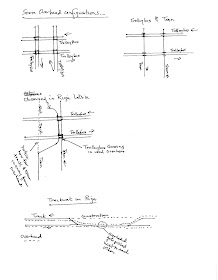- When a two way streetcar crossed a trolleybus line, the overhead hardware appears to be that of one trolleybus lane crossing another trolleybus lane at right angles. Or in other words, the two tramway wires, one let us say going south and one going north join to what looks like a 180 degree trolleybus crossing. This means for one of the tram wires will be significantly out of place and needs a long pole. See "Observed in Riga Diagram". Riga has a number of trolleybus lines. In order to avoid complex tram-trolleybus overhead hardwire at crossings, see top right diagram, a simple trolleybus crossing is used where one of the tram wires is significantly shifted. In a two way tram and trolleybus crossing, instead of having four pieces of complicated overhead you only need two.
- I believe that trams that have pantographs need more complicated overhead where there is a trolleybus crossing. This is avoided using trolley pole technology. Where there is trackwork, I see that the overhead in Riga is shifted significantly.
Tramway Null(0)
The picture to the right is a traditional trolleybus crossing. In Riga, this appears to be adopted for a tram - trolleybus crossing using one piece of equipment.



No comments:
Post a Comment